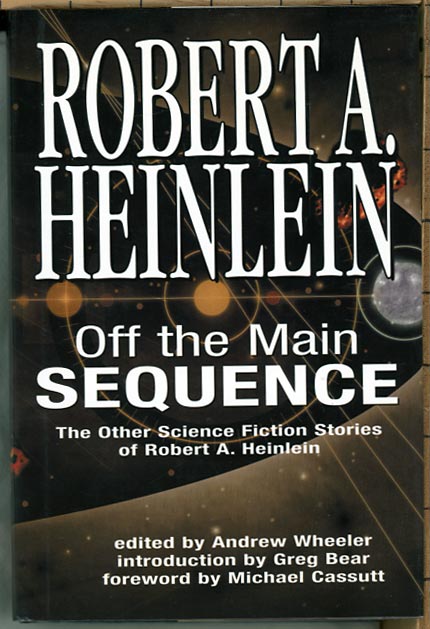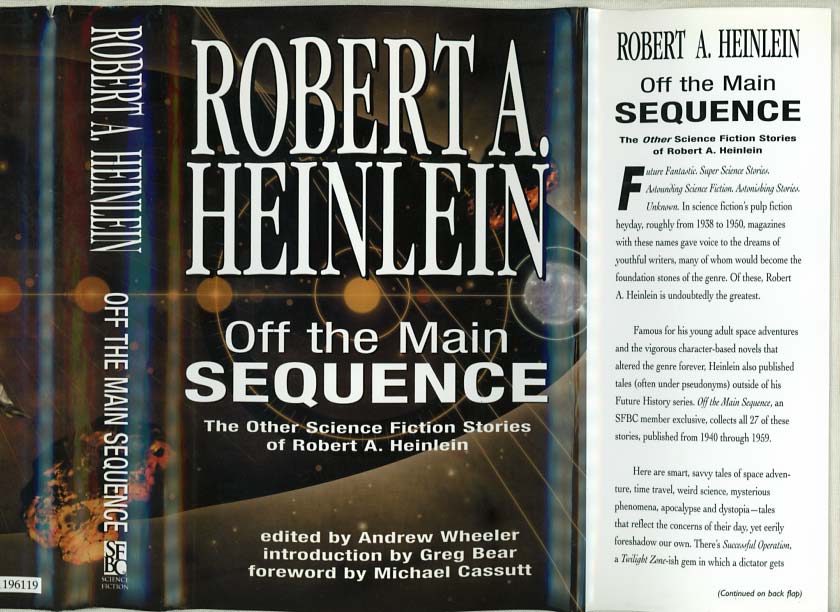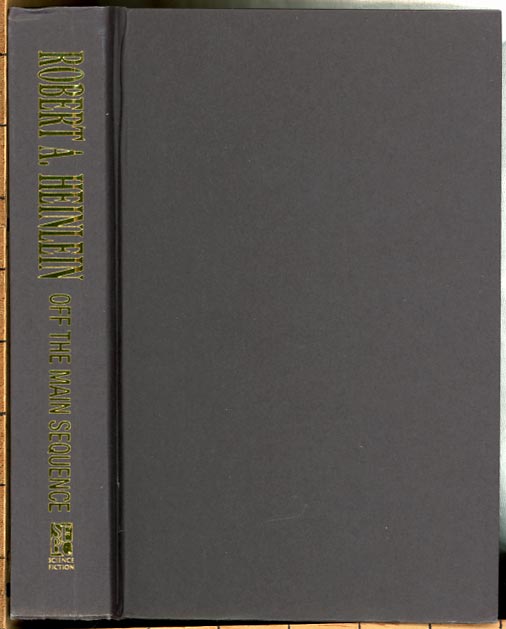
author:
title:
Heinlein, Robert A.
OFF THE MAIN SEQUENCE
book-date: 2005
edn-date:
printing:
format:
cvr art:
cvr price:
GRADING:
2005
Hardcover
Bruce Jensen
Book= VG+ or better
Dustjacket= Fine-
A hardcover collection of stories by Robert A. Heinlein: Off the Main Sequence. Selected by Andrew Wheeler (editor at SFBC), this collection is designed to complement The Past Through Tomorrow (1967)... with no duplications, and minimal overlap with The Fantasies of Robert A. Heinlein [1999 - an omnibus of Waldo & Magic, Inc. (1950) + The Unpleasant Profession of Jonathan Hoag (1959.)] More details follow the list of contents...
(Introduction by Greg Bear)
(Foreword by Michael Cassut)
(Editor's Note by Andrew Wheeler)
Successful Operation - {also titled "Heil!", 1970}
"Let There Be Light"
-And He Built a Crooked House
Beyond Doubt {w/ Elma Wentz}
They
Solution Unsatisfactory
Universe
Elsewhen
Common Sense
By His Bootstraps
Lost Legacy - (original title: "Lost Legion")
"My Object All Sublime"
Goldfish Bowl
Pied Piper
Free Men
On the Slopes of Vesuvius
Columbus Was a Dope
Jerry Was A Man - (original title: "Jerry Is A Man")
Water is for Washing
Nothing Ever Happens on the Moon
Gulf
Destination Moon
The Year of the Jackpot
Project Nightmare
Sky Lift
A Tenderfoot in Space
All You Zombies-
Most of these are from 1940 to 1959, and originally appeared in Futuria Fantasia, Astounding (7), Super Science Stories (2), Astonishing (2), Future, Startling Stories, Thrilling Wonder Stories, Unknown, Magazine of F&SF, Galaxy, Imagination, Amazing, Boy's Life (2), Short Stories, Argosy. 2 newer stories first appeared in The Worlds of Robert A. Heinlein (1966), and Expanded Universe (1980.)
This includes 4/4 of Assignment in Eternity (1953), 2/2 of Orphans of the Sky (1963), and 7/8 of The Menace from Earth (1959.) That missing story from The Menace from Earth can be found in The Past Through Tomorrow, and this collection picks up the only story from The Man Who Sold the Moon which The Past Through Tomorrow did not include. 3 very rare stories are first collected here, in addition to 3 stories from Requiem and 5 from Expanded Universe (1980 - which inflated the 1966 collection Worlds of Robert A. Heinlein without adding a lot of fiction.) So if you like the short science fiction of Heinlein and don't need the articles or essays or non-SF - this book gives you a third or more of his output.
For plot summaries of the stories first collected as Assignment in Eternity, here's an extract from a book review from ASTOUNDING May 1954:
"... I'd place them well ahead of Sixth Column, possibly ahead of The Puppet Masters, but not up to the best in the "Future History" series or the author's recent teen-age books. "Gulf" is a story even newer ASF readers may remember: a short novel of planetary intrigue in which an agent of the Federal Bureau of Security, trapped by a mysterious enemy, finds himself forced to depend on an even more mysterious ally with seemingly supernormal powers. The same theme appears in "Lost Legacy." Of the two shortest pieces, "Elsehen" is a mild episode in which a group of students travel mentally into other worlds, and "Jerry Was a Man" is the story of a humanized chimpanzee." [-P. Schuyler Miller]
Plot summaries for "Universe" and "Common Sense" - 2 related stories (usually marketed as the novel Orphans of the Sky) - which are included at the end of the "Future History" chart. They originally appeared in ASTOUNDING in 1941.
Back beyond the memory of any living on board was a great Mutiny in which the Captain and his officers perished. From that time it had been the duty of the scientists to promulgate the sublime laws of Jordan's Plan, to interpret such sacred books as Basic Modern Physics, to instruct the young in the ways of the Ship. The Ship is a giant sealed cylinder 5 miles long, with concentric decks, labyrinthine passages, acres of farmland, living area and work space. To novice scientist Hugh Hoyland it was the only world that existed - until one day he ventured into the weightless regions where the monstrous "muties" lived. There he learned the truth that had died with the first Captain and Crew… the true nature of the Ship.
For plot summaries of the stories first collected as The Menace From Earth, here are some parts of a review from ASTOUNDING/ANALOG July 1960:
...It opens with the eight-year-old "Year of the Jackpot," in which Heinlein uses the study of cycles and pyramids all kind of unconnected events into one tremendous peak of mishappenstance. Who else could weave so many unrelated elements together so smoothly, to drive at an inevitable climax? Then comes his classic "By His Bootstraps," published here back in 1941 and as good as it ever was. In this one Heinlein tackles the time travel paradox of the man who meets himself, and instead of weaseling around the edges of the problem, he meets it head on, with a burst of fireworks. Bob Wilson not only meets himself - he harries himself unmercifully, in an effort to remake the future... Just a year later, Astounding published "Goldfish Bowl." From a distance, it is one of Heinlein's lesser stories, but while you're in it the problem is real enough. Two gigantic columns of water are rising from the Pacific into the clouds; one carrying things up, one returning them. So, to find out who or what is causing the spouts, two men let themselves be drawn into the updraft - or, rather, plan to be drawn into it, since one is snatched away first by ball lightning. Finally, they find themselves in a kind of informationless cell in which they must reason out the nature of the mess they're in, and find a way of warning Earth... "The Menace from Earth," which is, however, a prime example of the author's skill at constructing realistic backgrounds in the most minute detail. Here the problem is not one of mad scientists or BEMs from outer space; the story's heroine is a teen-ager living on the Moon, who finds her boy friend dazzled by a glamorous tourist... "Project Nightmare" is a different matter and a far better story. A battery of psi-gifted people have to find nuclear bombs hidden in most of the larger American cities, and mentally prevent them from going off until they are disarmed. Here, as he doesn't often bother to do, Heinlein has created some genuine characters through their action and reaction under the mounting stress of the problem." [-P. Schuyler Miller.]

